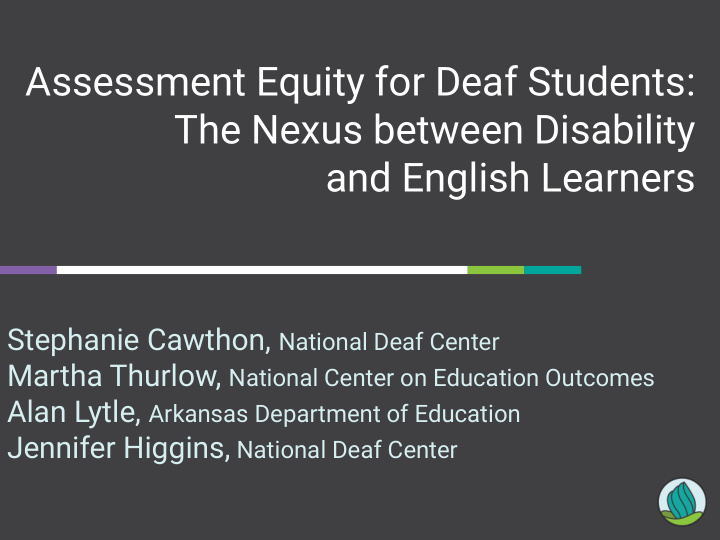



Assessment Equity for Deaf Students: The Nexus between Disability and English Learners Stephanie Cawthon, National Deaf Center Martha Thurlow, National Center on Education Outcomes Alan Lytle, Arkansas Department of Education Jennifer Higgins, National Deaf Center
Thank you, Alan!
Symposium Goal To examine testing equity for deaf students can be considered within the frameworks of both supports for Students with Disabilities and English Learners.
Road Map ▷ Understanding the population ▷ Accessible assessment ▷ ELP policy guidance ▷ Issues from the field ▷ Support for stakeholders
Population Demographics 50% with Sometimes arrive 1 % of students in additional without a robust special education disability first language 25% from Experience IEPs or 504s multilingual academic delays homes
What does deaf mean?
ASL Translation as an Access Strategy
ASL Translation: Core Equity Questions ▷ Item bias: Is there bias in the content of the test items? Is this question part of review or later measurement? ▷ Construct validity: Does the ASL translation change the content of the test item? ▷ Cultural relevance: Are there questions related to the cultural relevance or sensitivity of the test item? Are the ASL translations culturally embedded within the language?
ASL Translation: Evolving Best Practices ▷ Maintain linguistic structures in translation ▷ Team approach to development and documentation ▷ Certified Deaf Interpreters as key partners ▷ Feedback for item construction process
ASL Translation: Lingering Issues ▷ ASL acquisition trajectory ▷ Content areas and constructs ▷ Regional variations in signs ▷ Alignment with instruction ▷ Consistency and quality
Deaf Students as English Learners ▷ Recall: Approximately 25% of deaf students come from multilingual homes ▷ When might deaf students be eligible English Learner services?
Eligibility for EL Services ▷ Home Language Survey questions focus on language in the home environment ○ If home language is not English, referral to ELP screener ○ If ELP screener scores indicate not yet fluent in English, referral to EL services that provide support ○ Annual ELP test to determine if still eligible for EL services and supports
Issues and Challenges ▷ ASL as a home language does not refer for ELP screener. ▷ English language proficiency levels, without home language referral, does not refer for EL services. Stays within special education process. ▷ Special education supports and EL supports regulated by different sets of policies and guidance.
Learning from the Field
Case One A deaf fifth grade student is taking a mathematics assessment delivered in an online platform. Her English literacy proficiency is at about a first grade level. The student began learning sign language when she arrived in school and uses an interpreter in some of her classes, but is not on grade level in ASL in her receptive or expressive signing skills. The ASL translations for the online assessment are difficult for her to understand, even with multiple viewings. What should the IEP team consider for accommodations in this case?
Case Two An English Learner student who is on the autism spectrum is also deaf. Spanish is the language at home. The student is required to take an English Language Proficiency (ELP) screener exam with the four domains: Reading, Writing, Speaking, and Listening. What might the assessment team consider in the administration, scoring, and use of the ELP score?
Case Three A hearing student without a disability and from a Deaf family has American Sign Language as a home language. The student comes to school with what appears to be delayed English proficiency and might benefit from English learner services and supports. How does the school or district best support this student?
Case Four A district provides a remote interpreter for a student. The remote interpreter is located in another state. The student and the interpreter use close-circuit TV to communicate, and the interpreter has auditory access to the teacher via a mic-enabled headset. What should be considered when the district sets up the student’s state assessments?
Supporting the Field
National Deaf Center Mission NDC provides evidence-based strategies to deaf individuals, family members, and professionals at the local, state, and national levels with the goal of closing education and employment gaps for deaf individuals. 23 23
Funding Context ▷ Allocation is under IDEA ▷ OSERS → OSEP + RSA ▷ Technical Assistance & Dissemination
Systems Change
Task Force The purpose of an NDC task force is to convene thought leaders to discuss and identify issues related to data and best practices in a focused content area related to postsecondary outcomes for deaf individuals. Focus: Assessment Equity and Access
Resource Development WHY STANDARDS CHECKLISTS/GUIDES
nationaldeafcenter.org/learn
Success... together. 29
For More Information visit: nationaldeafcenter.org Or Email: help@nationaldeafcenter.org 30
Thank you! The National Deaf Center is funded by the Research to Practice Division, Office of Special Education Programs and the Rehabilitation Services Agency, and the US Department of Education via Cooperative Agreement #H326D160001 31
Recommend
More recommend